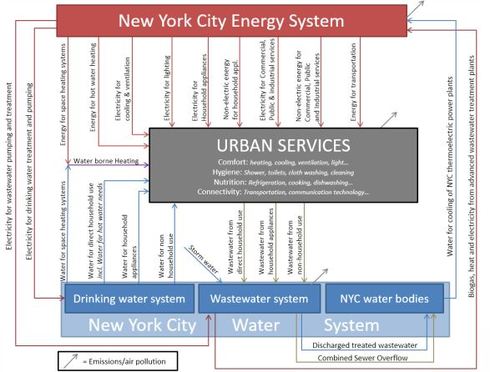About |
Cities are key contributors to climate change, responsible for as much as 75% of global greenhouse gas emissions. More and more cities are responding to this by developing ambitious climate mitigation strategies, improving their energy efficiency and switching to more “climate-friendly” fuels and technologies. However, climate, land, energy and water (CLEW) systems are interconnected, with resource uses and policies for one sector affecting the others.
|
|
Oskarshamn CLEWs
|
This project investigates the direct and indirect impacts on water and land resources of a local strategy for energy efficiency and climate change mitigation of the Oskarshamn municipality in southern Sweden. Multiple scenarios
A Long-range Energy Alternatives Planning System (LEAP) model of the municipal energy system is being developed that, in addition to energy sector inputs, includes water consumption and withdrawal data as well as land-use requirements for each technology option in the Oskarshamn energy system. A set of development scenarios are then analysed based on both how well they meet local and regional climate mitigation goals and on the magnitudes and patterns of their effects on local, national and international water and land resources. Support for this project comes from NOVA FoU and the strategic research program Ekoklim at Stockholm University. |
|
Urban water and energy systems are crucial for sustainably meeting basic service demands in cities. This paper proposes and applies a technology-independent “reference resource-to-service system” framework for concurrent evaluation of urban water and energy system interventions and their ‘nexus’ or ‘interlinkages’.
In a concrete application, data that approximate New York City conditions are used to evaluate a limited set of interventions in the residential sector, spanning from low-flow toilet shifts to extensive green roof installations. Results indicate that interventions motivated primarily by water management goals can considerably reduce energy use and contribute to mitigation of greenhouse gas emissions. Similarly, energy efficiency interventions can considerably reduce water use in addition to lowering emissions. However, interventions yielding the greatest reductions in energy use and emissions are not necessarily the most water conserving ones, and vice versa. Useful further research, expanding the present analysis should consider a broader set of resource interactions, towards a full climate, land, energy and water (CLEW) nexus approach. Overall, assessing the impacts, trade-offs and co-benefits from interventions in one urban resource system on others also holds promise as support for increased resource efficiency through integrated decision making. image source: Engström, et. al. (2017)
|

